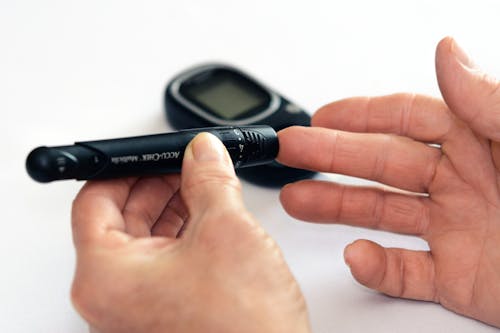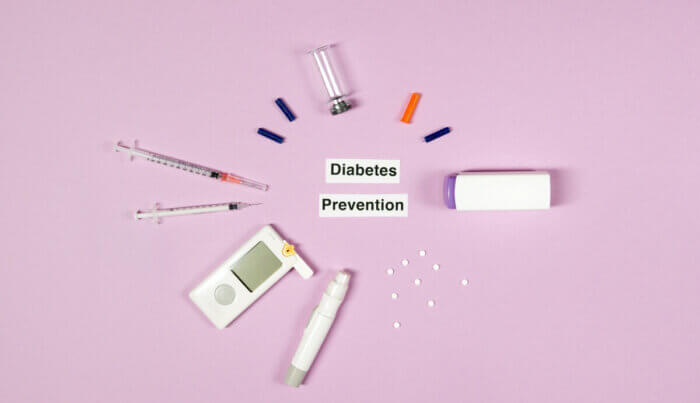Studies say that diabetes affects 422 million people globally. Type 2 diabetes affects more than 95% of those with the disease.
This typical type of diabetes impacts how our bodies control blood sugar or glucose. It frequently results from variables including obesity, sedentary lifestyles, and hereditary predisposition, and typically manifests in maturity.

What does being type 2 diabetes mean?
In this type of diabetes, cells don’t react normally with insulin. They ‘resist’ insulin, which acts like a ‘key’, opening the ‘doors’ of cells to allow sugar in. Your pancreas tries to make cells respond by increasing insulin production.
Your blood sugar eventually rises as a result of your pancreas’ inability to keep up, which can lead to type 2 diabetes and prediabetes.
Signs and symptoms
- The patient may feel thirsty and hungry more often.
- The frequency of infection may increase.
- The patient may get slow-healing sores.
- There may be frequent urination.
- The patient may feel numbness or tingling in the hands or feet.
- The patient may lose weight unintentionally.
- Injuries may take longer to heal.
Causes
1. This disease is caused by several factors: genes, lifestyle, eating habits, etc.
2. A prominent reason for the disease is the lack of physical activity. If you are less physically active, this can be a cause of contracting this currently incurable disease.
3. Eating habits also play their part here, especially if you’re obese. You should have a proper BMI (Body Mass Index).
4. The disease starts with insulin resistance. The cells do not utilise insulin well, and this results in sugar being accumulated in the blood.
5. Genes can also be a reason. You have to be extra careful if someone up your family tree has diabetes. You should have close control over your lifestyle, eating, etc. To keep fit, you should also exercise regularly.
Type 2 Diabetes Heart Palpitation
High levels of blood sugar are an important sign of type 2 diabetes, which is a chronic illness. It may result in several difficulties, including problems with the heart. People with type 2 diabetes may develop heart palpitations, which are fast or irregular heartbeats.
Although the exact cause of why people with diabetes have heart palpitations is not entirely known, it is thought that elevated blood sugar levels hurt the cardiovascular system.
Controlling blood sugar levels can help prevent heart palpitations and improve general heart health. Proper diabetes care includes medication, a good diet, regular exercise, and stress reduction.
Diabetics must carefully coordinate with their medical team to monitor their status and manage any heart-related issues that may arise.
Type 2 Diabetes Mellitus
High blood sugar levels are a chronic metabolic condition known as type 2 diabetes mellitus. It is often diagnosed in adulthood and is linked to unhealthy eating habits and inactivity.
Frequent urination, increased thirst, and weariness are symptoms. Changes in lifestyle, medicine, and routine blood sugar testing are all part of management. For reducing problems, early identification and effective care are crucial.
Type 2 Diabetes Diet
Diet for those with type 2 diabetes is vital for controlling blood sugar levels to improve general health. It includes selecting nutritious dietary selections that support controlling weight, blood glucose levels, and the risk of problems.
A variety of nutrient-rich foods, such as whole grains, lean meats, fruits, vegetables, and healthy fats, are often part of a balanced diet for type 2 diabetes.
Also, it focuses on mindful eating and quantity management. A proper meal plan that is suited to each person’s needs and tastes may be created with the help of a doctor or certified dietitian.
Effective management of type 2 diabetes requires regular blood sugar level monitoring and diet changes as necessary.
You might want to read this article: Diet and Nutrition: 10 Incredible Ways to enhance your eating habits.
How to deal with type 2 diabetes?
- Maintain a balanced diet and watch your portion amounts.
- Exercise frequently to control blood sugar levels.
- Regularly check your blood sugar and take any prescribed medicines.
- Use stress-reduction strategies.
- Attend routine checkups and look for assistance.
- Through a balanced lifestyle, control your weight.
- Limit your alcohol consumption and stop smoking.
- Maintain healthy cholesterol and blood pressure levels.
What is the difference between type 1 and type 2 diabetes?
Type 1 diabetes is an autoimmune illness in which the body lacks insulin and requires daily injections of insulin. Insulin resistance is a metabolic disease known as type 2 diabetes.
Diagnosing
Several tests and evaluations are required to diagnose diabetes and identify whether a person has the condition. Early diagnosis is essential for prompt management and intervention. Let’s look at the typical techniques for diagnosis.

Tests:
- A blood sugar test is the most used diagnostic procedure for diabetes. There are various kinds of blood sugar tests available, including:
- Fasting Plasma Glucose (FPG) Test: After a minimum of eight hours of fasting, this test determines your blood sugar level. Before eating breakfast or consuming any other food or drink, a blood sample is collected in the morning.
- Oral Glucose Tolerance Test (OGTT): For this test, you must first fast before ingesting a sweet beverage. To assess your body’s reaction to glucose, blood samples are obtained before and two hours after ingesting the beverage.
- No matter when you last had food, a blood sample is drawn for the random plasma glucose test. High blood sugar levels could be a sign of diabetes.
- Test for Glycated Haemoglobin (HbA1c): The HbA1c test gives you an average reading of your blood sugar levels over the previous two to three months. It calculates the proportion of haemoglobin that is bound to glucose. A higher HbA1c level suggests Type 2 diabetes and poorer blood sugar management.
It’s significant to remember that various nations and medical associations might have different diagnostic standards for this type of diabetes. Healthcare practitioners frequently adhere to the recommendations provided by the American Diabetes Association (ADA) and World Health Organisation (WHO).
If you are told you have diabetes, your doctor will probably order additional tests to establish how serious the condition is and how it will affect your general health. In addition to assessing other risk factors like blood pressure and cholesterol levels, they might also examine for problems.
How do you deal with it?
1. Medication for diabetes or insulin therapy is a very powerful way to manage this type of diabetes, but it can only be effective when you apply other methods to treat the disease. Employing a balanced and healthy diet and a suitable lifestyle helps. Again, if you haven’t already, I’d highly recommend you read my article on healthy eating or detox.
2. You really need to manage your BMI ( Body mass index ) and keep it in the green zone, because an unbalanced BMI may worsen your condition.
3. You must not stay inactive. You should keep yourself busy, working. You should exercise daily or play a sport for more enjoyment.
4. Your mental health matters too. Spend more time with your family and friends, instead of sitting with your nose glued to a screen. The happier you are, the more you can rest assured that your condition will not worsen.
Related: Loneliness and Mental Health: Effective Coping Strategies
Also, avoid eating street food as much as you can. Every culture has its own diet, intricately designed by our ancestors for that particular region, to give everyone a balanced diet. Why not stick to that?
Complications
1. Hypoglycemia
If you take more insulin than required, your blood sugar levels will plummet. This is called hypoglycemia. To prevent this, you should take the dose recommended by the doctor. If the problem still persists, you must talk to your doctor about this.
2. Heart palpitations
High glucose levels for diabetes patients can cause damage to the nerves that control your heart, and other blood vessels. You should regularly check your glucose levels to prevent this. Poor diabetes management, according to a study, may cause heart palpitations.
People with diabetes need to follow a healthy lifestyle that includes frequent exercise, a balanced diet, and good medication compliance.
Additionally, it is crucial to speak with a healthcare provider if you have diabetes and are having heart palpitations.
They can assess your symptoms, do the required tests, and provide you with the right advice based on your unique condition.
3. Neuropathy
If the disease causes damage to nerves in the legs and feet, there can be numbness or pain in the feet, hands, legs, etc. Problems with the blood vessels, heart, urinary tract, digestive system, etc. can also show up.
4. Kidney disease
If you’ve been a diabetes patient for a long time, I’d highly recommend visiting a nephrologist, as this disease can cause damage to the kidneys as well.
5. Eye Issues
High blood sugar levels might harm the small blood vessels in your eyes. If neglected, this may result in cataracts, blurred vision, or even blindness.
6. Slow healing
Your body’s natural healing process can be slowed down by high blood sugar levels. As a result, even a little cut or wound may take longer to heal, raising the chance of an infection.
7. Infections
Speaking of infections, high blood sugar can weaken your immune system, making it harder for your body to fight off infections. This means you’re more susceptible to things like urinary tract infections, skin infections, and even gum disease.
8. Diabetes can result in major health issues such as diabetic ketoacidosis and non-ketotic hyperosmolar coma.Diabetes is classified into two types: type 1 and type 2. . Type 1 is brought on by the body’s inability to create insulin as a result of an autoimmune reaction that kills the beta cells that release insulin, whereas type 2 is brought on by your pancreas’s failure to produce any or enough of this hormone.
How Insulin Works in Diabetes

The pancreas, a gland behind your stomach, produces the hormone insulin. Your body can utilise glucose for energy thanks to insulin. The highlights are as follows:
- The food you eat is converted into blood sugar by your body.
- When blood sugar enters your system, the pancreas responds by releasing insulin.
- For blood sugar to be utilised as fuel by the body’s cells, insulin aids in its absorption.
- The liver receives a signal from insulin to store blood sugar for later use.
- Blood sugar levels fall when sugar enters cells, which signals insulin to do the same.
- To ensure that energy is constantly available, even if you haven’t eaten in a while, lower insulin levels signal the liver to release stored blood sugar.
When everything runs without a hitch, that is. But this carefully calibrated system can easily get out of balance, as shown in the following:
- The bloodstream absorbs a lot of blood sugar.
- To get blood sugar into cells, the pancreas releases more insulin into the body.
- Cells develop resistance to insulin over time and stop responding to it.
- The pancreas continues to produce more insulin to get cells to react.
- Blood sugar levels continue to rise as the pancreas fails to keep up.
What is the role of glucose?
A major source of energy for the cells that make up muscles and other tissues is glucose, a sugar. The following are some examples of how glucose is used and regulated:
- The two main sources of glucose are food and the liver.
- Insulin helps glucose enter cells once it is taken into circulation.
- Glucose is created and stored by the liver.
- To maintain the body’s glucose level within a healthy range when glucose levels are low, the liver converts glycogen that has been stored into glucose.
In type 2 diabetes, the insulin-producing cells of the pancreas eventually suffer damage and are unable to produce enough insulin to meet the body’s requirements.
What are the risk factors?
- Family history: Your risk is higher if you have a close relative who has type 2 diabetes, such as a parent or sibling.
- Sedentary lifestyle: Not getting enough exercise puts you at risk for type 2 diabetes.
- Unhealthy Eating Patterns: A diet high in processed foods, sugar-sweetened beverages, and trans fats can hasten the onset of diabetes. Related: Food Processing: 5 Silent Health Risks
- Obesity: Having type 2 diabetes is significantly increased by being overweight or obese.
- Age: Our chance of having diabetes rises as we age. This is partially due to the possibility that with time, our bodies may utilise insulin less effectively.
- Gestational Diabetes: Women who have had gestational diabetes during pregnancy are more likely to develop type 2 diabetes later in life. After giving delivery, they must continue to practise healthful behaviours.
- Ethnic Background: Type 2 diabetes is more common in some ethnic groups, including African Americans, Hispanics, Native Americans, and Asians. This elevated risk may result from a mix of genetic and environmental factors.
Is type 2 diabetes very serious?
Yes, type 2 diabetes has to be managed and treated properly as it is a serious condition. If not under control, it can cause several issues and have a detrimental effect on general health. Working closely with medical specialists is crucial for managing type 2 diabetes and reducing its risks.
Can type 2 diabetes be cured?
While there is no perfect cure for type 2 diabetes, it may be managed and controlled with dietary adjustments, medication, and routine medical attention. People with type 2 diabetes may lead healthy, meaningful lives with the right care. Maintaining a healthy lifestyle, keeping an eye on blood sugar levels, and adhering to the specified treatment schedule is important.
How long can a person live with type 2 diabetes?
Having type 2 diabetes can affect a person’s life expectancy in many ways, depending on their general health, their lifestyle decisions, and how effectively they manage their illness. Type 2 diabetics can lead long and fruitful lives with good treatment and control of blood sugar levels and a healthy lifestyle.
Conclusion
Even though millions of individuals globally suffer from type 2 diabetes, diabetes’s crucial to recognise that diabetes may be prevented or controlled by making wise choices including eating well, exercising, maintaining a healthy weight, and occasionally taking medication.
Early detection and efficient management of this condition can reduce the risk of complications and improve the quality of life for individuals who battle it. Due to continuous research and cutting-edge treatments, those who suffer from this condition have hope for a better future.



2 thoughts on “Type 2 Diabetes: How to Understand and Treat Symptoms.”